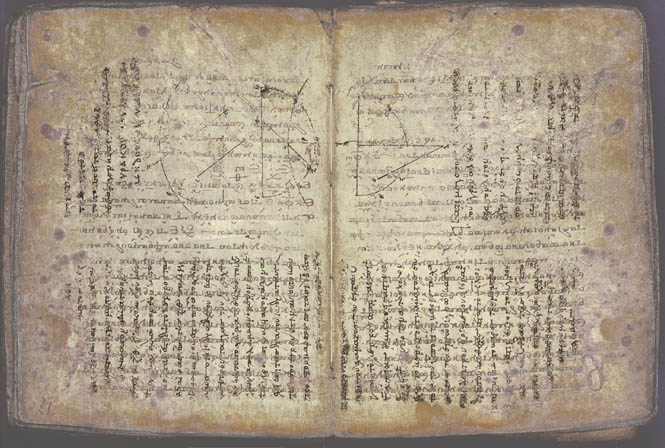By chance, have you ever heard of the word “palimpsest”? I’m going to guess the answer is no, but this unique sounding word is helpful in understanding what cultural landscapes are, how they are formed, and how to interpret or produce meaning from them, all of which are the topics of this chapter.
Let’s take a closer look.
According to Merriam-Webster dictionary, a palimpsest is “writing material (such as a parchment or tablet) used one or more times after earlier writing has been erased” and “something having usually diverse layers or aspects apparent beneath the surface.”
Below is a photograph of a prayer book, with traces of what was previously written on the parchment pages, which were mathematical notes by Greek mathematician Archimedes.

Before paper, books were made up of pages of parchment, which was typically made from animal skin and was scarce and pricey. This meant that instead of discarding an out-of-use book, the original text would be scraped off the parchment and new text would be layered on. The trace of what came before was figuratively palpable and literally present. You can see this on the page above.
Landscapes are accumulations of the past–both natural and human-made past influences, spanning from the recent past to the distant past. Like books, they can be read or interpreted. Instead of words on the page signifying the meaning, natural and human-made forces and elements that have shaped the landscape signify the landscape’s meaning. Cultural landscapes specifically examine how human systems and forces shape landscape more so than natural forces.
Interpreting Cultural Landscapes
There are a few models we can follow that guide us in how to interpret cultural landscapes and cultural regions, or areas with similar cultural influences.
The first is the core-domain-sphere model foregrounded by geographer Donald Meinig, who examined the Mormon cultural landscape in the United States. To interpret this landscape, he looked for the layers of Mormon culture embedded within the American Mormon region and what kinds of signatures the culture left/leaves in terms or architecture, business type, spatial arrangement of residential and commercial establishments, etc. The idea of this model is that the cultural influences are strongest at the core of the region and diffuse from there in a diluted way.

(Image by author)
According to this model, the core of the Mormon cultural region would be characterized by comparatively higher rates of the following as compared with with the domain and sphere: church attendance, religious billboards, brunch traffic at restaurants after services, restrictions on how much alcohol is served at at time in bars and restaurants reflecting the Mormon value of restraint, etc. Likewise, there would be a lack of certain aspects within the core as compared with other regions, like tattoo and piercing shops, which are classically discouraged within Mormon culture.
When you’re interpreting landscapes, consider examining the following aspects or layers and how they reveal the past, reflect the present, and shape the future of a place:
- Infrastructure (layout, type/purpose, architecture)
- Names (of neighborhoods, buildings, streets, sports teams)
- Natural (presence or removal or arrangement of trees; water systems; role of natural elements in shaping built environment; how human systems and infrastructure are adapted to the environment)
- Local customs (examples: Do people stand in line or is it a free-for-all? Are crosswalks marked and followed by pedestrians?)
- Other material and immaterial culture (see section below)
Exercise: Core-domain-sphere model
Think of a culture and/or way of life with which you have familiarity–perhaps this is gaming culture, farming culture, urban culture, etc. Apply the core-domain-sphere model to your case study.
- How well does the core-domain-sphere model apply to your case study? Describe a specific example of a cultural aspect that fits with the model and another aspect that diverges from it. If you don’t think the model applies at all, discuss why that might be. Are there aspects of contemporary society and how culture diffuses that might limit the utility of this model nowadays, or not?
Another way to approach landscape interpretation is by paying special attention to both material and nonmaterial culture. Material culture relates to the various tangible objects made and used by culture. Many of these material artifacts are given meaning by the culture and can even change over time. Nonmaterial culture refers to intangible ideas that cultures have that are not tied directly to material objects. These beliefs are often attached to place.
Let’s use these ideas of material and nonmaterial culture to read cultural landscapes. The United Nations Educational, Scientific and Cultural Organization (UNESCO) has a list of cultural landscapes. The following short videos show several of these landscapes.
Uluru-Kata Tjuta National Park (UNESCO/NHK) video
Questions (for video above)
- How do the cave paintings relate to culture?
- Discuss the importance of water in this cultural landscape. How is this importance embedded in place?
Cultural Landscape and Archaeological Remains of the Bamiyan Valley video (UNESCO/NHK)
Questions (for video above)
- How can we tell that a large political/national change occurred within this landscape?
- Which cultural groups (Taliban, Buddhists) did which things to the landscape?
Questions (for video above)
- How has history, time, and scale impacted this landscape?
- How has the local culture changed over time vis-à-vis the labor and treatment of both children and horses?
Questions (for video above)
- What do fences tell us about the culture? About the geography of this location?
- Do the people living here use indigenous/traditional methods and knowledge, or new methods and knowledge?
The Rice Terraces of the Philippine Cordilleras video UNESCO (NKH)
Questions (for video above)
- Names of places and objects have importance on the cultural landscape. What does the language and naming in this landscape tell us about the local history and tradition?
- Discuss the form and function of the terrace structures. What ideas from culture are imbued in these structures?
- How is local infrastructure adapted to the agricultural practices in the video?
Questions (for video above)
- Tequila often has a Declaration of Origin, which certifies that the product is from Mexico and produced according to strict guidelines. What does a Declaration of Origin tied to a drink tell us about cultural identity?
- What aspects of cultural syncretism, which refers to a co-evolution of cultures or the influence of one culture on another resulting in blended cultural products, processes, and beliefs, do you see?
Questions (for video above)
- What do the Western clothing and artifacts tell us?
- What is the relationship between people and livestock and how is that reflected or revealed in the landscape?
model to understand density of cultural features within a place
tangible objects made and used by culture
intangible ideas that cultures have that are not tied directly to material objects. These beliefs are often attached to place.
certifies a product is from a particular place and adheres to strict guidelines
a co-evolution of cultures or the influence of one culture on another resulting in blended cultural products, processes, and beliefs
